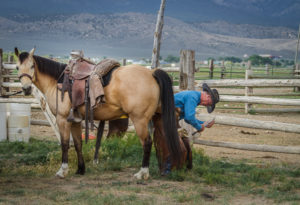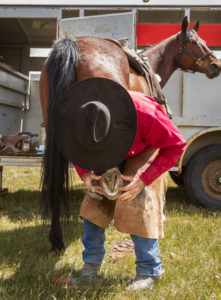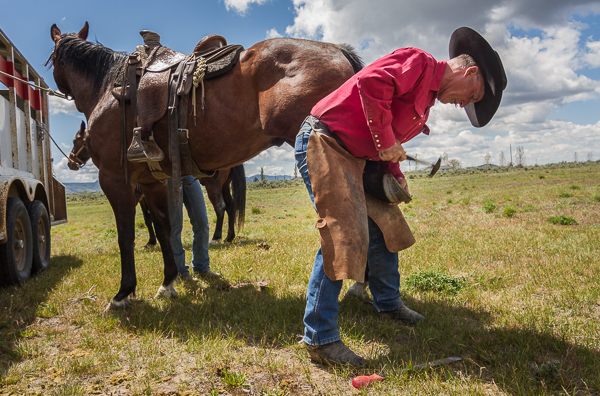Horsemanship with Martin Black

As a horseman and a farrier, Martin Black understands the value of a horse that knows how to stand still for trimming and shoeing. Photo credit: Shinanatu, Kim F Stone Photography, shinanatu.com; used with permission.
Many of the well-known clinicians and horse trainers today spend a lot of their time talking about how to train a horse under saddle or how to “make” a horse do things. Martin Black of Bruneau, Idaho is different in that he not only spends time on the horses, but also working on their feet as well. As a horseman and a farrier, Black understands the value of a horse that knows how to stand still and stand on three legs to accommodate a farrier.
I recently spoke to Martin Black on his philosophies in training horses. He made it clear up front that he doesn’t like the word, “training.” He said:
“First of all, the whole ‘training’ thing has a sour tone to it. A lot of us don’t refer to it as ‘training’ an animal…you know, it’s more of a ‘communication’ thing. We aren’t ‘teaching’ these horses anything that they haven’t already done…we teach them to stop and turn and take their leads and balance in certain ways. It’s kind of like teaching an athlete. They’ve got to already know the moves. We might refine them and get more effort out of them, but most of the people in my circle think of it more like a communication thing, and the communication comes from us. They aren’t going to speak our language. We have to learn their language.”
Black went on to say, “It’s more [that] we’re training ourselves. If someone’s learning something, we’re training ourselves to think more like a horse, which is a prey animal and we think like predators. The challenge for a lot of people is to get out of that mindset that we’re gonna leave the cave with a big stick, and go kill something and bring it home. That’s kind of how we think and that’s where a lot of people get in trouble with their horses.”
This can be a problem for a lot of starting farriers. Farriers tend to be very results-driven. While this drive can be a good thing, it can also cause problems when approaching horses. Horsemanship is vital to be a successful farrier. If a farrier isn’t taking time to try to understand the horse, it can end in an explosive fight.
Working with horseshoeing students in the last several years, I’ve noticed the ones who take the time to understand horses and the ones that don’t. Some people may put on a front that they are competent and confident horsemen, but horses tell the truth every time. The horse recognizes every worry, insecurity, fear and aggressive thought immediately. Or as Martin Black put it, “The horse knows you’re mad before you know you’re mad.”
One time, I observed a beginning farrier approach a horse. The horse began to fidget and dance around whenever this person was near. As soon as the person moved away, the horse would settle down. I knew the horse had been shod several times in the past and the horse never seemed to have any problem standing still. The person began to complain about the horse’s movement and visibly appeared frustrated. He asked, “Why is this horse moving around? Is he scared or something?” I said that the horse was “reading” the person and reacting to his anger and fear. The person became defensive and said, “I ain’t scared of this horse! I’d ride the sh— out of this horse!” That type of aggression was exactly what was worrying the horse! Unfortunately, the person couldn’t see things from the horse’s perspective.

Martin Black shoeing his horse. Photo credit: Photo Credit: Shinanatu, Kim F Stone Photography, shinanatu.com; Used with permission.
The first step to successfully getting a horse to stand still for trimming and shoeing is to control our own emotions. That can be really difficult because trimming and shoeing can be such precise work. Farriers may get so entrenched in what they are doing – trying to shape the shoe right, trying to fit the shoe to the foot, trying to get nails to come out in the right place, etc. – that they forget that they are working with a living animal! I saw an otherwise good farrier cause an otherwise well-behaved horse to flip over backwards in the middle of an exam because the farrier was so stressed about the outcome of the test. The horse was picking up on the farrier’s stress and nerves. The owner of the horse was surprised to see her horse so agitated when the horse was usually fine.
In instances where we may feel frustration for any part of the job, it is best to take a break and come back to it when we’ve calmed down. I’ve advised students to do this and some have taken that advice and others have not. The ones who do step away for a minute and relax with some breathing exercises or some other way of calming down usually have a better outcome with the horse. The ones that try to just plow through their anger and stick it out usually end up in a fight.
Another thing that a farrier can do to help a horse stand still during the trimming or shoeing job is to ensure the horse is comfortable by holding its foot in the proper position. Some farriers, in order to avoid the discomfort of crouching down to hold the foot, stand up too straight and make the horse uncomfortable by holding its leg up too high; pushing the horse off balance. If the horse is comfortable and balanced, it is more likely to stand and make the farrier’s job easier. Along those same lines, a farrier can encourage a horse to stand still for trimming and shoeing by making the horse uncomfortable when it chooses to move around.
Martin Black explained it in this way:
“If the horse does pull away or is not standing still I might slap them or poke them just enough they’re bothered; just accelerate their movement slightly more than what they bargained for, not enough to panic them. Standing still with me holding a foot up is the most comfortable option they have. The other thing is if the horse is not standing or starts leaning while I am underneath them I may just raise the foot up or pull it out to where they are slightly more uncomfortable. Sort of like twisting someone’s arm up behind their back to an uncomfortable point. Then give them a chance to balance better on the other 3 feet by bringing the foot to a more comfortable position.”
Black has a unique perspective on teaching horses to stand for trimming and shoeing that differs from some other clinicians. He doesn’t like to “desensitize” a horse and remove the flight so much that the horse doesn’t pay attention to the farrier. He said, “I don’t want the horse to tune me out or be desensitized to what I’m doing. [A horse that is desensitized] is the horse that you have to grab his foot and lift him off the ground and he might be leaning on you.” He described his method to condition a horse to pick up its foot:
“The first time I might pick the foot up and clean it; set it down and go to the next foot; go around to all four feet, so he never has to stand [with one leg up] for very long…If that horse picks his foot up and sets it down several times, pretty quick – and this is where I like a sensitive horse – I just bend over and reach for the foot and the horse picks the foot up and meets me halfway. That horse is the horse that is going to balance better on the other three legs. He’s not gonna pull the foot away from me. He’s not gonna be leaning on me. I like to have a horse that’s a little more sensitive; a little more tuned in. Not that he’s scared or oversensitive in that way, but I like to have one that’s a little more tuned in and says, ‘How can I help make your job easier?’”
Understanding horse behavior and a horse’s perspective will make the job easier for the farrier. Horsemanship is so important in farriery. We should always be striving to understand the horse or as Martin Black puts it, “to rise to the level of the horse.”
To hear Martin Black talk more about these horsemanship principles, you can listen to the whole interview on the Farrier Focus podcast here.
Related Posts
-
Distance riding competitions have become popular in the Unit...Sep 19, 2019 / 0 comments
-
Recent events have taken a toll on various horse people and ...Aug 30, 2012 / 0 comments
-
By Doug Butler PhD, CJF, FWCF Lee Liles passed away May 12, ...May 17, 2018 / 0 comments
Blog Categories
- Anatomy
- Best Business Practices
- Conformation
- Current Events
- Customer Service
- Draft Horse Shoeing
- Equine Soundness
- Essential Anatomy Kit
- Farrier Careers
- Farrier training
- Foal soundness
- Horse Care
- Horse Foot Care
- Horse Owner Tips
- Horsemanship
- Horseshoeing
- Horseshoeing History
- Iron and Forge Work
- Student Spotlight
- Uncategorized
- Veterinary Care
Blog Archives
Contact Us
Butler Professional Horseshoeing School
495 Table Road
Crawford, NE 69339
(800) 728-3826
jacob@dougbutler.com
Subscribe to Our Blog
Get Our Free e-Book!
If you think you want to become a farrier (or know someone who does), this book can help you make that decision. Horse owners will learn the importance of choosing a qualified farrier and how to select the “right” one.
[ Get the e-Book Now! ]
- Follow:

